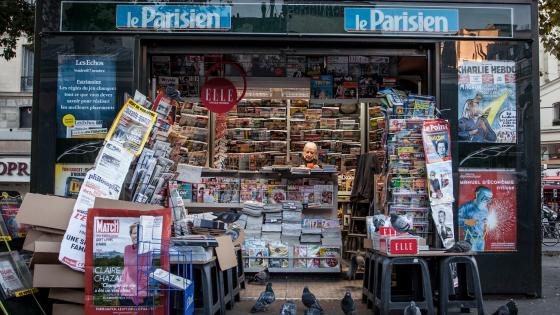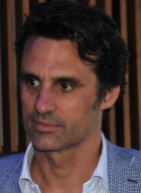Editors’ note: This blog is a long version of an op-ed published in The Guardian on 30 November 2022: “The UK reined in Rupert Murdoch. Why can’t we stop Vincent Bolloré in France?”.
In 1789, the Declaration of the Rights of Man and of the Citizen, adopted by France’s National Constituent Assembly, noted in its Article 11 that “the free communication of thoughts and of opinions is one of the most precious rights of man: any citizen thus may speak, write, print freely.”
Today, Articles 4 and 34 of the French Constitution proclaim respectively the “pluralist expressions of opinions” and the “freedom, pluralism and independence of the media.”
And yet, media pluralism is at risk in France.
Yes, in France.
This statement might sound surprising to outside observers who, when considering threats to media freedom in Europe, tend to think of Poland or Hungary (e.g. Szeidl and Szucs 2021).
But pluralism is undoubtedly under threat today in the Hexagon, due to the rising power of the Bolloré Group. This family holding is already the principal shareholder of Vivendi, a global company that owns leading assets in television and movies (in particular through the Canal+ Group, including the 24-hour news channel CNews, the French equivalent of Fox News);
an advertising and public relations company (Havas SA); assets in the publishing sector, in particular with Editis, France’s second-largest publisher; Prisma Media, the country’s leading magazine publishing group; as well as the global digital content distribution platform, Dailymotion. The Bolloré Group is now trying via Vivendi to acquire the Lagardère Group, a transaction that has been notified to the European Commission on 24 October 2022. If Vivendi were to entirely acquire Lagardère – it has steadily increased its shareholding in the group since 2020 – Bolloré’s company would additionally take full control of one of the main French private radio stations, Europe 1, as well as of the two main weekly newspapers in France: Le Journal du Dimanche and Paris Match. Not to mention its acquisition of Hachette, the French and European leader in the publishing industry.
Media pluralism is at risk in France; in November 2021, a commission of inquiry was established by the French Senate to look at the concentration of media ownership, in particular at the rising power of Bolloré. While observers agreed that Bolloré poses a real danger to press freedom, the commission did not really succeed: no solution was found. In November 2022, a deputy filed a complaint against Hanouna, the star host of Bolloré’s channel C8 for having insulted him – the MP was called “shift” and a “buffoon” on air; Hanouna’s show goes on, as if nothing happened. And just after, another MP carried a proposal aimed to put an end to the concentration in the media; again unsuccessfully. More than ever, the solution seems to be in the hands of the European Commission. We think it is urgent to fully inform this debate.
On November 30th 2022, the European Commission opened an in-depth investigation to assess, under the EU Merger Regulation, the proposed acquisition of Lagardère by Vivendi; it will render its decision on April 19th 2023. Margrethe Vestager, the European Commissioner for Competition, has said multiple times that this buyout will only be analysed from a competition standpoint, i.e. without taking into account the fact that Vincent Bolloré, the head of Vivendi, is a media mogul who has repeatedly used his control over the news media as a tool to try to influence French elections – most notoriously in recent years by promoting far-right politician Éric Zemmour’s ideas (Cagé et al. 2021) and giving him several hours per week of free propaganda on his news channel CNews. Nor will she allow for the fact that Bolloré is well known for censoring a range of content (most notably, investigations into his business activities in Africa and elsewhere), deciding what appears on the front cover of magazines, and firing journalists who have tried to stand up to his meddling (Cagé 2022).
The decision will be taken from the competition standpoint. So be it. And yet, competition should not be approached in the same way for the media industry as for other industries, because information is a public good (Anderson and Coate 2005, Cagé and Huet 2021) and thus cannot be reduced to market shares. First, media pluralism needs to be taken into account. Why? Because pluralism should be considered as one of the dimensions of the quality of the media. A good market for news is one that exposes audiences to a variety of competing voices and perspectives to encourage debate and make the truth more likely to emerge (Prat 2020). As we document later in this article, the proposed merger would put one man in control of news reaching one third of the French adult population; that lack of variety is far from ideal from the perspective of news consumers. In that event, citizens will indeed get a less diverse and informative news diet.
Competition authorities have a duty to protect consumers from this significant loss of pluralism. This was made very clear in the 2018 decision of the Competition & Market Authority (CMA) – the competition regulator in the United Kingdom – regarding the anticipated acquisition by 21st Century Fox of Sky News; the the CMA highlights in its decision (relying on section 58(2C)(a) of the Enterprise Act 2002) “the need, in relation to every different audience in the United Kingdom or in a particular area or locality of the United Kingdom, for there to be a sufficient plurality of persons with control of the media enterprises serving that audience”. And notes that “the consideration of media plurality goes to the heart of our democratic process and as such is given particular protection in legislation”. How is media plurality defined? The CMA uses Ofcom’s definition, pointing out the need to prevent “any one media owner, or voice, having too much influence over public opinion and the political agenda.” In the case we are interested in here – the acquisition of Lagardère by Vivendi – and given Vincent Bolloré has never hidden his desire to influence content at the media outlets owned by his group, we might be legitimately afraid by the fact that this acquisition could reduce the diversity of viewpoints available to and consumed by members of the French public.
Second, the European Commission responsible for competition might consider that pluralism is the responsibility of national media regulatory authorities, not of the European competition authority. While this argument is understandable, two weaknesses of the French context must be stressed. On the one hand, the French law is no longer relevant to guarantee media pluralism in the digital age. This law indeed dates back to 1986 and does not take into account the reality of information consumption behaviours in the 21st century. Just one example: still today, regarding newspapers, only the daily newspapers are regulated by specific articles limiting concentration, not weekly or monthly newspapers or news websites; similarly, online television channels do not enter the articles setting limits to broadcast concentration (Cagé and Huet 2021). However, it is absurd to consider these types of media separately – whether a daily or weekly newspaper, a news website or a television news channel – through which people access a piece of news in the digital age in which they are consuming news simultaneously through a variety of media (Cagé et al. 2020). On the other hand, and perhaps even more importantly, the French media regulation authority, the Arcom, has been deficient on many occasions in recent years as a regulator of the media and guarantor of pluralism. Hence, the European Commission responsible for competition needs to intervene to guarantee pluralism in France.
New regulations on competition for the media have been put in place in recent years at the EU level, in particular as part of the Digital Markets Act (DMA) and the Digital Services Act (DSA) (Johnson 2022), which introduced the concepts of “gatekeepers” and “core platform services” – both the EU Parliament and Council have also repeatedly highlighted the need to promote pluralism and independence in the media market (and pluralism is at the core of the novel European Media Freedom Act). Specifically, a gatekeeper is considered to be any company that operates a service with more than 45 million monthly active end users, i.e. around 10% of the EU population.
What does this approach tell us about the announced acquisition of Lagardère by Vivendi? Even if we ignore the issues linked to the publishing industry (Vivendi will most probably divest 100% of its subsidiary Editis), the acquisition raises competition issues for the news media. With the different magazines of the Prisma Group, Vivendi already reaches more than 16.1 million adults in France on a regular basis (with an audience of 1.5 million for Capital, 2.9 million for Géo, 2.4 million for Ça m’intéresse, 1.2 million for Gala, 1.7 million for Voici, 3.2 million for Télé-Loisirs, 1.8 million for Télé 2 semaines, and 1.4 million for TV Grandes Chaînes) – i.e. nearly 30% of the French adult population. If it were also to take control of Le Journal du Dimanche (with an audience of 1.2 million) and Paris Match (with 2.6 million), then the group would reach more than a third of the adult population. This far exceeds the 10% threshold introduced by the new European regulations, and is also well above what we will achieve with an “old-style market shares approach”, which was valid at a time when people were reading (and buying) their newspapers and magazines solely in paper format but is now irrelevant in a world where citizens are reached by news brands through multiple channels (beginning with social media).
Furthermore, regarding Vivendi’s desire to buy Lagardère, we should not only consider horizontal but also vertical competition. As we have already highlighted, Vivendi owns assets not only in the media sector but also in the communication and advertising industry as well as in the publishing sector. What is more, through Olympia Production, it also owns a booking agency as well as a show and concert promoter for music artists and stand-up comedians. And what have we seen in the last few months? Increasing synergies between these different activities, with Vivendi’s promoted artists appearing on the front page of Vivendi-owned magazines thanks to the intervention of Vivendi’s advertising agency, Havas. Journalists such as Laurence Ferrari are also present in all the different media companies owned by the group: Ferrari presents a show on the television channel CNews, another on the radio channel Europe 1 and, since September 2022, is the editor-in-chief of Paris Match’s political service.
Regulating media concentration and ensuring media pluralism raises a number of challenges in the digital age. But we can save pluralism. The acquisition of Lagardère by Vivendi can be blocked, as the UK did in 2018 for the merger between 21st Century Fox and Sky. Rupert Murdoch, who already controlled The Times of London and The Sun wanted to gain full control over Sky News. The proposed operation was ok in a narrow antitrust sense because the companies were active on different platforms. However, the UK’s Competitions and Markets Authority (CMA) realised that something else was at stake and it set itself the objective – we highlighted it – to guarantee media plurality. Through rigorous analysis of news consumption patterns, the CMA showed that the two companies together would have controlled approximately 10% of the attention share of the British public for political news; the merger was abandoned.
Media pluralism is at risk today in France – and could soon be in jeopardy in other countries. Hence, we have no other choice but to rethink competition entirely, in particular in an era of disinformation where a number of democracies are under threat (Allcott and Gentzkow 2017, Allcott et al. 2019). We need to completely re-examine our traditional views on media competition: we can no longer simply think in terms of market shares but also need to take into account the attention shares (Prat 2018, Kennedy and Prat 2019). Let us be clear: what is at stake today is not just the media in France but also our collective ability to redefine media pluralism and market power in a new geopolitical context where democracy itself is more fragile than ever.
References
Allcott, H and M Gentzkow (2017), “Social Media and Fake News in the 2016 Election”, Journal of Economic Perspectives 31(2): 211–36.
Allcott, H, M Gentzkow, and C Yu (2019), “Trends in the Diffusion of Misinformation on Social Media”, Research & Politics.
Anderson, S P, and S Coate (2005), “Market Provision of Broadcasting: A Welfare Analysis”, The Review of Economic Studies 72(4): 947–72.
Cagé, J (2022), Pour Une Télé Libre. Contre-Bolloré, Le Seuil.
Cagé, J, M Hengel, N Hervé, and C Urvoy (2021), “Hosting Media Bias: Evidence from the Universe of French Broadcasts, 2002-2020”, Sciences Po Paris Working Paper.
Cagé, J, N Hervé, and M-L Viaud (2020), “The Production of Information in an Online World”, The Review of Economic Studies 87(5): 2126–64.
Cagé, J and B Huet (2021), L’information Est Un Bien Public. Refonder La Propriété Des Médias, Le Seuil.
DellaVigna, S, and E Kaplan (2007), “The Fox News Effect: Media Bias and Voting”, The Quarterly Journal of Economics 122(3): 1187–1234.
Johnson, G A (2022), “Economic Research on Privacy Regulation: Lessons from the GDPR and Beyond”, in Economics of Privacy, University of Chicago Press (also NBER Working Paper 14784).
Kennedy, P J and A Prat (2019), “Where Do People Get Their News?”, Economic Policy 34(97): 5–47.
Martin, G J and A Yurukoglu (2017), “Bias in Cable News: Persuasion and Polarization”, American Economic Review 107(9): 2565–99.
Prat, A (2018), “Media Power”, Journal of Political Economy 126(4): 1747–83.
Prat, A (2020), “Measuring and Protecting Media Plurality in the Digital Age. A Political Economy Approach”, Knight First Amendment Institute at Columbia University.
Szeidl, A, and F Szucs (2021), “Media Capture Through Favor Exchange”, Econometrica 89(1): 281–310.

















